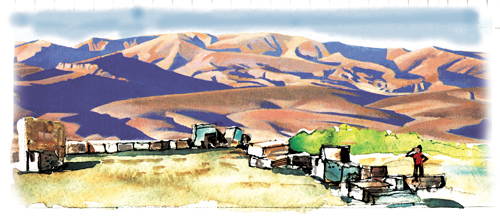Fort Piute not easy to get to, but worth the effort
Constructed in 1859, a tiny outpost near Piute Creek in the Mohave National Preserve provided shelter in times of trouble for a handful of soldiers stationed along the Mojave Road, or Old Government Road. This major travel route cut across the Mojave Desert from Fort Mohave on the Colorado River, linking a series of fortified water sources spaced about 20 dry miles apart, including Fort Piute. The Mojave Road remains open today only to four-wheel drive traffic.
Visitors to Fort Piute today must either hike several miles from a modern graded road to the west or approach from U.S. 95 to the east using several miles of rough, graded roads and one short stretch of the Mojave Road. Hiking or driving, visitors should schedule this adventure during the cool months.
For this outing, carry a gallon of drinking water per person per day and extra for your vehicle. Make sure you have a good spare tire and know how to change it. Equip yourself with a detailed map such as AAA's San Bernardino County or National Geographic's topographical map of the area. Let a responsible person at home know where you are headed and when you expect to return. Cell phone contact may be intermittent or nonexistent.
Hikers begin their six and a half mile roundtrip by driving nine and a half miles south from Cedar Canyon Road to Lanfair Road to a dirt utility road, where they turn east for about half a mile. The trail drops from a hill into Piute Gorge. Piute Springs feeds a creek crowded with stands of trees and thick vegetation. The ruins of Fort Piute lie above the creek near a low, rocky pass. Hikers often opt to return following the Old Mojave Road, where wagon tracks cut into the stone in the 1860s still remain visible.
Southern Nevadans choosing the approach by road follow U.S. 95 south from Las Vegas to a point six and a half miles south of the Nevada-California border. Turn right onto a graded road and head west seven and two-tenths miles to a road running north and south. Turn right and head north one and four-tenths miles. Watch for a very rough track heading west to a dark little cleft in the Piute Mountains that marks the pass to Piute Creek. This part of the route was actually part of the original road. Follow this tire-buster carefully two miles to the ruined walls of the old fort or park your vehicle and walk the rest of the way.
Because of its reliable water, the desert canyon drew the hunters and gatherers of prehistory. Later cultures planted patches of corn, beans, squash and cotton in the canyon. Rival cultures may have clashed over use of the area. Indications of its importance to early desert people lie upon the boulders of the hillside where natives left petroglyphs carved into the dark stone surfaces.
Native groups of the area at first welcomed light-skinned explorers when they probed the unknown lands of a continent new to Europeans, but home to many native peoples. Local natives even helped guide early Spanish explorers and remained cooperative as late as the early 1800s, when mountain men followed rivers and trails while trapping and mapping the area. Hostility began to build when more strangers following these maps to establish trade routes were soon followed by settlers who moved into areas vital to the local natives.
The clash of cultures led to enough trouble with hostile area natives that the United States military built a chain of intermittently manned outposts or redoubts across the Mojave Desert. When troops were recalled during the Civil War, Fort Piute and other posts were manned by California militia. Regular army units returned after the war. Completion of the railroads across the continent and shirting of overland travel to other routes, including steamboat traffic on the Colorado, reduced the need for the outposts. Fort Piute was abandoned in 1868, but served for a time as a relay station on a stage route.
Visitors see remnants of thick rock walls and two buildings and a corral. Fortifications included high walls along a passage connecting the corral and the main buildings, rifle ports with metal deflector shields and fortified picket posts for sentries. Unless under attack, the soldiers lived in tents near the stone structures.
Margo Bartlett Pesek's column appears on Sundays.






















